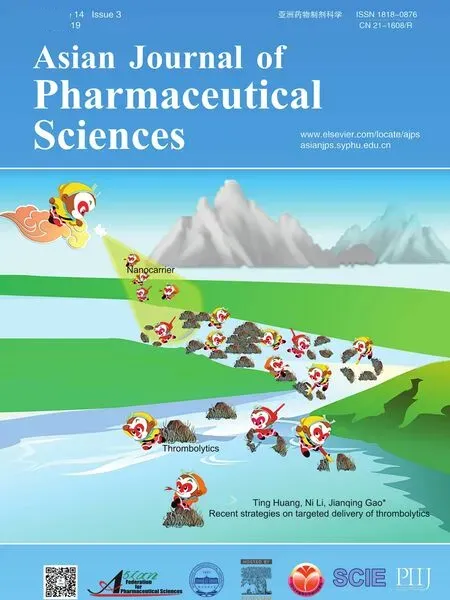Cover story
Thrombosis is o ne of the l eading causes of mo rtality and morbidity globally [1]. The formation of thrombus is attributed to the altern ations in hemorheo logy, abno rmalities in the endothelium/endocardium, or imbalance amid procoagulant, coagulant and f ibrinolytic path ways. Fo r the tr eatment of thrombotic disease, throm bolytic drugs, namely plasminogen activators (PA) are widely us ed in clinic. H owever, th e adverse effects of PA such as allergic reactions and bleeding complications, a nd their sho rt half life limit their furthe r applications. To solve these problems, targeted d rug delivery systems (D DSs) of thrombol ytics are being developed. Current strategi es on targete d deliver y of th rombolytics mainly involve appl ying ultraso und or magn etic field as external stimulu s to guide responsive drug carriers to thrombosed site, modifying drug carriers to allow their specific binding to thro mbus compone nts, and utilizin g inherent homing ability of biological dr ug carriers [2]. Moreover, novel theranostic approaches w hich can diagnose and treat diseases simult aneously hold great p romise d ue to th eir ability to monitor therapeutic outcomes.
In this issue, Prof. Jianqing Ga o and his team di scussed recent p rogress on t argeted de livery of t hrombolytics, an d summarize their advantages and shortcomings. The targeted DDSs of thromb olytics can be briefly divided into artificial DDSs which load drugs into nano/micro-carriers or a re designed as pro drug construc t, and biological DDSs w hich are composed of cells or their fragments. Artificial DDSs of thrombolytics can achieve efficient targeting through diverse nanoparticles. For biological DDSs of thrombolytics, red blood cells are mostly used as drug carriers because of their great biocompability a nd long circulat ion time. This review of Professor Jianqing Gao p resents the curr ent views on targeted delivery of th rombolytics, highlights the a dvantages and disadvantag es of different DDSs of thromb olytics, and helps to further promote the development of targete d thrombolysis.
In the f ront cov er, Prof essor Jianqing Ga o and his team used the Chinese epic story 'Journey to the West', one of the four great classic novels of Chinese literature to vividly illustrate the targeted delivery of thrombolytics. Sun Wukong, a major character in 'Journey to the West', has the ability to shrink the size of his body, duplicate himself by blowing his fur, and go to wherever he wants. Inspired from th is famous character, Pro fessor Jianqing Gao and his tea m visualized varied targeted thrombolytics carriers as different duplications of Sun Wukong. The river and stone represent the vessel and thrombus, respectively. T he river blocked b y aggregated stones are being dredged by little Sun Wukong, which refers to the targeted thrombolytic process.
 Asian Journal of Pharmacentical Sciences2019年3期
Asian Journal of Pharmacentical Sciences2019年3期
- Asian Journal of Pharmacentical Sciences的其它文章
- Double-layered osmotic pump controlled release tablets of actarit:In vitro and in vivo evaluation
- Study of penetration mechanism of labrasol on rabbit cornea by Ussing chamber,RT-PCR assay,Western blot and immunohistochemistry
- In vitro/vivo assessment of praziquantel nanocrystals:Formulation,characterization,and pharmacokinetics in beagle dogs
- Formulation of a film-coated dutasteride tablet bioequivalent to a soft gelatin capsule(Avodart?):Effect of γ-cyclodextrin and solubilizers
- Percutaneous absorption and brain distribution facilitation of borneol on tetramethylpyrazine in a microemulsion-based transdermal therapeutic system
- Effects of granulation process variables on the physical properties of dosage forms by combination of experimental design and principal component analysis
